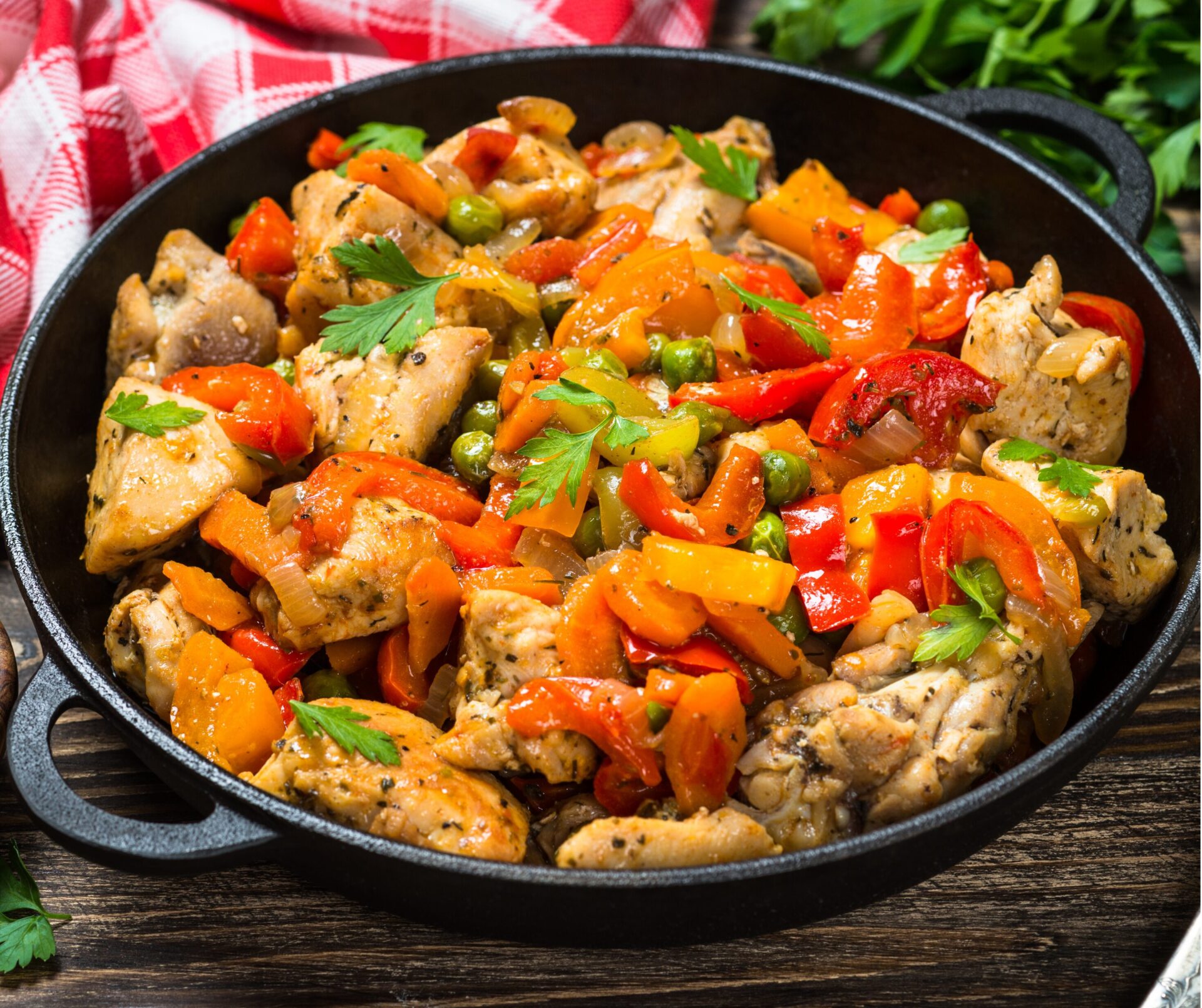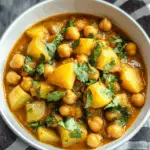Chicken stir-fry is the epitome of quick, versatile cooking that combines simplicity with a burst of flavors and textures. Rooted in ancient Chinese culinary traditions, stir-frying has become a beloved cooking method worldwide, celebrated for its ability to transform basic ingredients into a delicious and nutritious meal in mere minutes. This chicken stir-fry recipe captures the essence of this technique by bringing together tender chicken, crisp vegetables, and a savory-sweet sauce that will have your taste buds dancing with every bite.
What makes chicken stir-fry so appealing is its adaptability. With just a few staple ingredients like soy sauce, fresh vegetables, and spices, you can whip up a satisfying dish that suits your palate and dietary preferences. It’s a fantastic way to incorporate lean protein and an array of colorful vegetables into your diet, all while maintaining a balance of flavors that range from sweet and savory to a hint of spicy heat. Whether you’re looking for a quick weeknight dinner or a flexible recipe to clear out your fridge, chicken stir-fry offers endless possibilities.
Full Recipe:
Ingredients
- Chicken (breasts or thighs)
- Soy sauce
- Sugar
- Cornstarch
- Spices (e.g., fresh ginger, garlic, red pepper flakes)
- Vegetables (e.g., broccoli, bell peppers, carrots)
- Water chestnuts
- Sesame oil
- Rice (for serving)
Directions
- Marinate the Chicken: Stir together the soy sauce, sugar, cornstarch, and spices. Add the chicken pieces and toss to coat. Cover and let it marinate.
- Cook the Vegetables: In a pan, cook the vegetables and water chestnuts in sesame oil until tender.
- Cook the Chicken: In the same pan, cook the marinated chicken until it’s no longer pink. Then, stir in the cooked vegetables and any reserved marinade.
- Finish and Serve: Boil the mixture until the chicken is fully cooked. Serve hot over a bed of rice.
Tips
- Best Chicken for Stir-Fry: Both chicken breasts and thighs work well, but ensure the pieces are small and uniform for even cooking.
- Customizable Vegetables: Use any leftover vegetables you have on hand, such as mushrooms, asparagus, or snap peas.
- Serving Suggestions: This dish is complete with protein, veggies, and rice, but you can serve it alongside dishes like pork dumplings, fresh spring rolls, or hot and sour soup for a fuller meal.
- Storage: Store leftovers in an airtight container in the refrigerator for up to five days. Reheat in the microwave or on the stove, adding a splash of water if the rice dries out.
Community Reviews
- Jen: “A quick, easy, and delicious way to use leftover vegetables. I added mushrooms, and it just makes it that much better!”
- Rita: “The sauce is delicious, sweet, and just a bit spicy. My family loved this dish.”
- Lauretta Jean Campbell: “I used asparagus instead of broccoli because it’s what I had on hand. We ate it immediately—no chance for a photo!”
Recipe Overview
Chicken stir-fry is a classic dish in many Asian cuisines, particularly in Chinese cooking. This quick and easy recipe brings together tender chicken, fresh vegetables, and a savory-sweet sauce for a meal that’s ready in minutes. The dish is highly customizable, allowing you to use your favorite vegetables or whatever you have on hand, making it perfect for busy weeknights or when you need a healthy, balanced meal in a hurry.
Ingredients and Variations
- Chicken: The recipe is versatile enough to work with either chicken breasts or thighs. Chicken breasts are leaner, while thighs offer a juicier, richer flavor. The key is to cut the chicken into small, uniform pieces to ensure even cooking.
- Marinade: The marinade typically consists of soy sauce, sugar, cornstarch, and spices.
- Soy Sauce: Adds a salty, umami flavor. You can use low-sodium soy sauce if you’re watching your salt intake.
- Sugar: Balances the saltiness of the soy sauce with a hint of sweetness.
- Cornstarch: Helps thicken the sauce and gives the chicken a slightly glossy finish.
- Spices: Fresh ginger, garlic, and red pepper flakes add depth and a bit of heat to the dish. Feel free to adjust the spice level to your taste.
- Vegetables: This recipe can accommodate a wide variety of vegetables. Common choices include broccoli, bell peppers, carrots, snap peas, and mushrooms. Water chestnuts add a crunchy texture. You can also use vegetables like asparagus, bok choy, or zucchini depending on your preference.
- Sesame Oil: Used for cooking the vegetables, it adds a nutty, aromatic flavor. If sesame oil is not available, you can use vegetable oil or olive oil.
Cooking Process
- Marinate the Chicken: Marinating the chicken in soy sauce, sugar, cornstarch, and spices allows the flavors to penetrate the meat, making it more flavorful and tender. A quick marinade of 15-30 minutes is sufficient, but you can marinate for longer if you have time.
- Cook the Vegetables: Cooking the vegetables first in sesame oil ensures they retain their crisp-tender texture. Start with harder vegetables like carrots and broccoli and add softer vegetables later to avoid overcooking.
- Cook the Chicken: In the same skillet or wok, cook the marinated chicken until it is no longer pink. The cornstarch in the marinade helps to create a slightly thickened sauce as the chicken cooks.
- Combine and Finish: Add the cooked vegetables back into the pan with the chicken. Stir in any reserved marinade and bring it to a boil to ensure the chicken is fully cooked and the sauce thickens.
Tips and Adaptations
- Cooking Utensils: Use a wok or a large skillet to cook the stir-fry. These provide enough surface area for even cooking and allow the ingredients to be tossed and stirred easily.
- Customize the Sauce: Adjust the soy sauce and sugar to balance the saltiness and sweetness to your liking. Add a splash of rice vinegar or lemon juice for acidity, or a drizzle of honey for a sweeter taste.
- Add Nuts: For extra crunch and flavor, consider adding cashews or peanuts during the final stages of cooking.
- Gluten-Free Option: Use gluten-free soy sauce or tamari for a gluten-free version of this stir-fry.
- Meal Prep: Chicken stir-fry is an excellent meal prep option. Cook a large batch and store individual servings in airtight containers. The dish can be refrigerated for up to five days, making it a convenient lunch or dinner option.
Nutritional Benefits
- High Protein: Chicken is a great source of lean protein, which is essential for muscle growth and repair.
- Vitamins and Minerals: The vegetables in the stir-fry provide a range of vitamins and minerals, including vitamins A and C, fiber, and antioxidants.
- Balanced Meal: When served over rice, this stir-fry offers a balanced mix of protein, carbohydrates, and fiber, making it a satisfying and nutritious meal.
Serving Suggestions
- Rice: Serve the stir-fry over steamed rice (white, brown, or jasmine) to soak up the flavorful sauce.
- Noodles: Alternatively, serve it over noodles like soba, udon, or rice noodles for a different twist.
- Side Dishes: Pair the stir-fry with Asian-inspired sides such as pork dumplings, fresh spring rolls, or hot and sour soup for a more elaborate meal.
Community Reviews and Suggestions
- Customization: Many users appreciate the versatility of this recipe. They often add their favorite vegetables or adjust the sauce’s sweetness and spice levels to suit their family’s taste.
- Quick and Easy: Reviewers love how quickly this dish comes together, noting that it’s perfect for using up leftover vegetables in the fridge.
- Flavorful Sauce: The sauce is often praised for its balance of sweet, savory, and spicy notes. Some users suggest adding extra garlic or ginger for a more intense flavor.
History of Chicken Stir-Fry
Origins of Stir-Frying
Stir-frying is a cooking technique that originated in China over 2,000 years ago during the Han dynasty. It involves cooking food quickly at high heat in a wok, a round-bottomed cooking vessel. The wok’s design allows for even heat distribution, making it perfect for stir-frying. This technique was developed not only for its efficiency but also due to the limited availability of cooking fuel in ancient times. Stir-frying allowed food to cook rapidly, conserving fuel and preserving the natural flavors and nutrients of the ingredients.
- Spread Across Asia: As stir-frying gained popularity in China, it spread throughout Asia, influencing cuisines in countries like Japan, Korea, Thailand, and Vietnam. Each region adapted the technique, incorporating local ingredients and flavors. For instance, in Southeast Asia, stir-fries often include fish sauce, lemongrass, and various spices.
- Introduction to the West: Chinese immigrants introduced stir-frying to the Western world in the 19th and early 20th centuries. In the United States, Chinese-American cuisine began to flourish, and stir-fried dishes like chop suey and fried rice became popular in American homes and restaurants. The stir-fry technique was embraced for its speed and the ability to create nutritious, flavorful meals using a variety of ingredients.
Chicken Stir-Fry: A Modern Adaptation
Chicken stir-fry, as we know it today, is a modern adaptation of traditional Chinese cooking methods. In its classic form, stir-frying involves quickly cooking thinly sliced meat and vegetables in a small amount of oil, often with soy sauce, ginger, garlic, and other seasonings.
- Versatile and Adaptable: The beauty of chicken stir-fry lies in its adaptability. In Chinese cuisine, chicken is commonly stir-fried with ingredients like broccoli, bell peppers, and carrots. However, as this dish made its way into Western kitchens, cooks began adding various vegetables and sauces, making chicken stir-fry a versatile dish that can incorporate local tastes and available ingredients.
- Health and Convenience: By the mid-20th century, stir-frying had become associated with quick, healthy cooking. The technique allows for the retention of nutrients in vegetables due to the short cooking time, and lean proteins like chicken make the dish both nutritious and light. In Western culture, the chicken stir-fry became a staple for those seeking a balanced meal that could be prepared in a matter of minutes.
Benefits of Chicken Stir-Fry
1. Quick and Easy Preparation
- Fast Cooking: Chicken stir-fry is known for its speed. With minimal prep work and a short cooking time, this dish can be on the table in under 30 minutes. The quick cooking process makes it ideal for busy weeknights when time is of the essence.
- Simple Ingredients: The recipe uses basic ingredients like chicken, vegetables, soy sauce, and spices, which are often pantry staples. This simplicity makes it an accessible option for cooks of all skill levels.
2. Nutritional Benefits
- Lean Protein: Chicken is a lean source of protein, low in fat and high in essential nutrients such as niacin, vitamin B6, and phosphorus. It supports muscle growth and helps maintain a healthy metabolism.
- Vegetable-Rich: By incorporating a variety of vegetables, chicken stir-fry provides a broad spectrum of vitamins, minerals, and dietary fiber. Vegetables like broccoli, bell peppers, and carrots add vitamins A, C, and K, along with antioxidants that help boost the immune system.
- Balanced Meal: When served with rice or noodles, chicken stir-fry becomes a balanced meal that includes protein, carbohydrates, and fiber. This combination supports sustained energy and satiety, making it a wholesome option for lunch or dinner.
3. Versatility and Customization
- Adaptable to Preferences: One of the key benefits of chicken stir-fry is its versatility. You can customize it with your favorite vegetables, proteins, and sauces. Swap chicken for tofu or shrimp, or use whatever vegetables you have on hand to create a unique version every time.
- Dietary Flexibility: Chicken stir-fry can be adapted to fit various dietary needs. It can be made gluten-free by using gluten-free soy sauce or tamari. For a low-carb option, serve it over cauliflower rice instead of traditional rice. Vegetarians can substitute chicken with tofu or tempeh for a plant-based meal.
4. Healthier Cooking Method
- Minimal Oil: Stir-frying requires minimal oil compared to other cooking methods like deep frying, making it a healthier option. Using heart-healthy oils like olive or sesame oil adds beneficial fats without excess calories.
- Nutrient Retention: The high heat and short cooking time of stir-frying help preserve the nutrients in vegetables. Unlike boiling or slow cooking, stir-frying ensures that vitamins and minerals remain intact, providing more nutritional value in each bite.
5. Economical and Resourceful
- Budget-Friendly: Chicken stir-fry is cost-effective. It utilizes affordable ingredients like chicken and vegetables, and it’s an excellent way to use up leftover produce in the fridge. This reduces food waste and makes it an economical choice for families.
- One-Pan Meal: Stir-frying is typically done in a single pan or wok, which means fewer dishes to wash. This one-pan approach not only saves time in preparation and cleanup but also makes cooking more efficient.
Conclusion
Chicken stir-fry is a dish steeped in history, originating from ancient Chinese culinary practices and evolving into a beloved staple around the world. Its popularity lies in its simplicity, versatility, and the ability to deliver a nutritious, balanced meal quickly. Whether you’re using it to clear out your vegetable drawer or crafting a fresh, vibrant dinner, chicken stir-fry is a go-to recipe that adapts to your needs while providing a delicious and wholesome dining experience.






